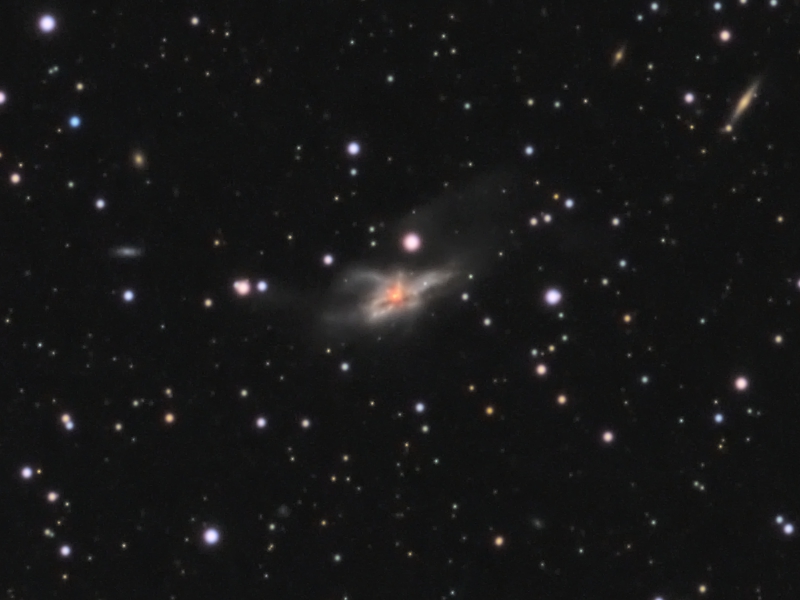NGC 6240
Published 20 July 2021
Click image above for larger field of view
About this object
NGC 6240 is a really small magnitude 12.8 irregular galaxy in the constellation Ophiuchus. Its distorted shape is the result of a on going galaxy merger where two galaxies are being drawn close together and merging into one. This process has caused stars to be flung out from both and you can see that in the faint tidal streams of stars that show up as hazy areas around the galaxy. The galaxy is called a ultra luminous galaxy as the two black holes at the cores of the parent galaxies spiral in close to each other and are emitting copies amounts of infrared light.
Being so small this galaxy looks best imaged from a large telescope but I was determined to see what resolution I could get from my 6" refractor. Even small instruments can reveal most of the general detail. The image is a small crop of a much larger field of view taken at a resolution of .64 arcsec/pixel. Click on the image to see a much larger field of view and I included the full annotated field of view showing how small this object is. Here is a link to the Hubble Space Telescope image of NGC 6240: https://www.nasa.gov/image-feature/goddard/hubble-revisits-tangled-ngc-6240
Discussion about NGC 6240 from NASA.gov: NGC 6240 lies 400 million light-years away in the constellation of Ophiuchus (The Serpent Holder). This galaxy has an elongated shape with branching wisps, loops and tails. This mess of gas, dust and stars bears more than a passing resemblance to a butterfly and a lobster.
This bizarrely-shaped galaxy did not begin its life looking like this; its distorted appearance is a result of a galactic merger that occurred when two galaxies drifted too close to one another. This merger sparked bursts of new star formation and triggered many hot young stars to explode as supernovae. A new supernova, not visible in this image was discovered in this galaxy in 2013, named SN 2013dc.
At the center of NGC 6240 an even more interesting phenomenon is taking place. When the two galaxies came together, their central black holes did so, too. There are two supermassive black holes within this jumble, spiraling closer and closer to one another. They are currently only some 3,000 light-years apart, incredibly close given that the galaxy itself spans 300,000 light-years. This proximity secures their fate as they are now too close to escape each other and will soon form a single immense black hole.
NGC 6240 is a really small magnitude 12.8 irregular galaxy in the constellation Ophiuchus. Its distorted shape is the result of a on going galaxy merger where two galaxies are being drawn close together and merging into one. This process has caused stars to be flung out from both and you can see that in the faint tidal streams of stars that show up as hazy areas around the galaxy. The galaxy is called a ultra luminous galaxy as the two black holes at the cores of the parent galaxies spiral in close to each other and are emitting copies amounts of infrared light.
Being so small this galaxy looks best imaged from a large telescope but I was determined to see what resolution I could get from my 6" refractor. Even small instruments can reveal most of the general detail. The image is a small crop of a much larger field of view taken at a resolution of .64 arcsec/pixel. Click on the image to see a much larger field of view and I included the full annotated field of view showing how small this object is. Here is a link to the Hubble Space Telescope image of NGC 6240: https://www.nasa.gov/image-feature/goddard/hubble-revisits-tangled-ngc-6240
Discussion about NGC 6240 from NASA.gov: NGC 6240 lies 400 million light-years away in the constellation of Ophiuchus (The Serpent Holder). This galaxy has an elongated shape with branching wisps, loops and tails. This mess of gas, dust and stars bears more than a passing resemblance to a butterfly and a lobster.
This bizarrely-shaped galaxy did not begin its life looking like this; its distorted appearance is a result of a galactic merger that occurred when two galaxies drifted too close to one another. This merger sparked bursts of new star formation and triggered many hot young stars to explode as supernovae. A new supernova, not visible in this image was discovered in this galaxy in 2013, named SN 2013dc.
At the center of NGC 6240 an even more interesting phenomenon is taking place. When the two galaxies came together, their central black holes did so, too. There are two supermassive black holes within this jumble, spiraling closer and closer to one another. They are currently only some 3,000 light-years apart, incredibly close given that the galaxy itself spans 300,000 light-years. This proximity secures their fate as they are now too close to escape each other and will soon form a single immense black hole.
Image Details
- Optics : Stellarvue SVX 152T refractor @f8 1200mm FL
- Mount: Paramount MYT
- Camera: ZWO ASI6200
- Filters: Chroma 50mm LRGB
- Exposure (min): LRGB 267:190:225:185 14hrs, 27min, 1x1 binning 1/2 frame
- Automation Control: The Sky X, Voyager, PrimaluceLab Eagle 4
- Guiding: StarlightXpress Lodestar X2
- Processing Software: PixInsight, PS CC, Topaz Labs
- Location: Stark Bayou Observatory, Ocean Springs, MS
- Sky: Typical SQM 19.6-20.1, Bortle 5, Suburban
- Date: 8 May - 4 July 2021







